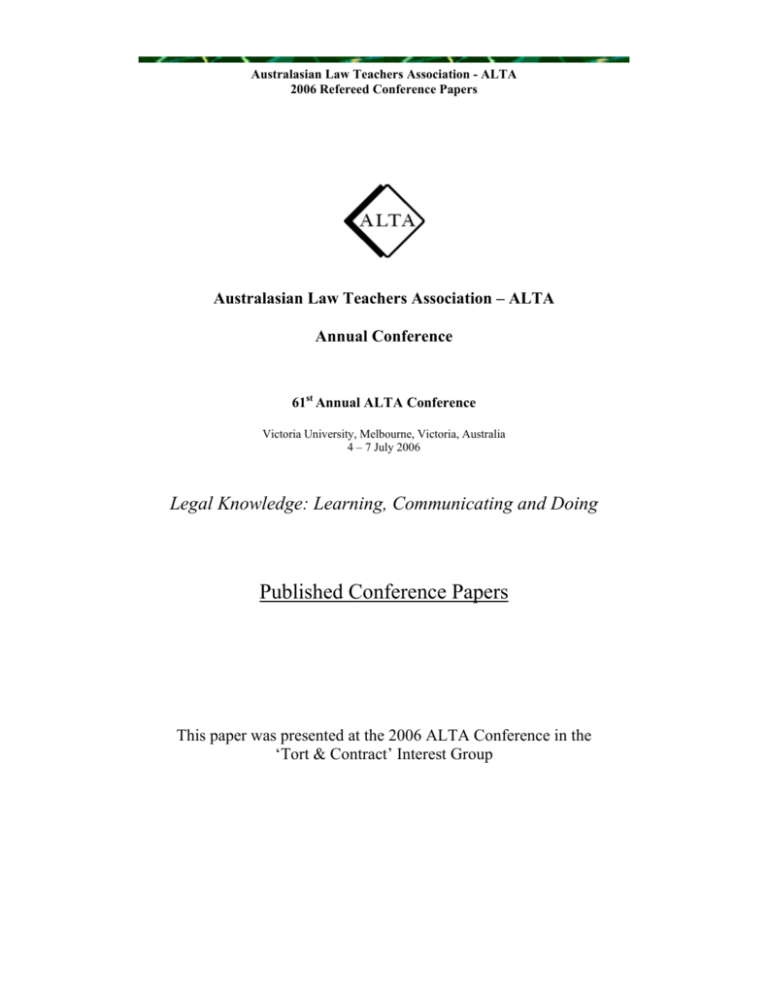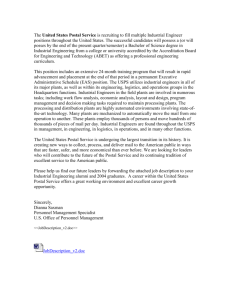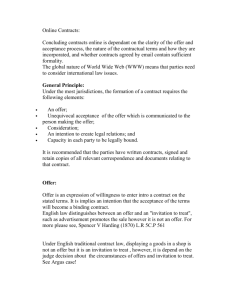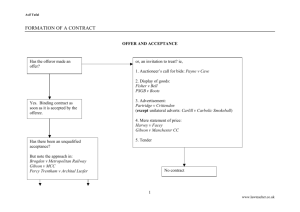Challenged but not defeated by technology
advertisement

Australasian Law Teachers Association - ALTA 2006 Refereed Conference Papers Australasian Law Teachers Association – ALTA Annual Conference 61st Annual ALTA Conference Victoria University, Melbourne, Victoria, Australia 4 – 7 July 2006 Legal Knowledge: Learning, Communicating and Doing Published Conference Papers This paper was presented at the 2006 ALTA Conference in the ‘Tort & Contract’ Interest Group Australasian Law Teachers Association - ALTA 2006 Refereed Conference Papers The Australasian Law Teachers Association (ALTA) is a professional body which represents the interests of law teachers in Australia, New Zealand, Papua New Guinea and the Pacific Islands. Its overall focus is to promote excellence in legal academic teaching and research with particular emphasis on supporting early career academics, throughout Australasia, in the areas of: (a) Legal research and scholarship; (b) Curriculum refinements and pedagogical improvements in view of national and international developments, including law reform; (c) Government policies and practices that relate to legal education and research; (d) Professional development opportunities for legal academics; (e) Professional legal education and practices programs. Conference Papers published by the ALTA Secretariat 2006 Edited by Professor Michael Adams, Professor David Barker AM and Ms Samantha McGolrick Associate Editor Janet Fox ALTA Secretariat PO Box 222 Lindfield NSW 2070 AUSTRALIA Tel: +61 (2) 9514 5414 Fax: +61 (2) 9514 5175 admin@alta.edu.au www.alta.edu.au 2 Australasian Law Teachers Association - ALTA 2006 Refereed Conference Papers CHALLENGED BUT NOT DEFEATED BY TECHNOLOGY: WHY THE POSTAL RULE SHOULD APPLY TO CONTRACTS FORMED BY EMAIL DEBRA RONAN∗ ∗ Associate Lecturer, Division of Law, Macquarie University, Australia. 3 Australasian Law Teachers Association - ALTA 2006 Refereed Conference Papers I INTRODUCTION An entrenched general principle of contract law is that commercially aware parties may enter into legally binding agreements in whichever way, and subject to such terms, as they chose. Contracts may be formed using any medium sufficient to display the legal requirements for the formation of a binding contract; thus a binding agreement may be evidenced in writing, verbally, or implied from the conduct of the parties.1 It is now also firmly established that contracts can be entered into by electronic means using on-line forms of communication via the Internet. Because the domain of the Internet flows indiscriminately across international boundaries, jurisdictional problems arise when contractual disputes arise. Therefore determination of the time and place of formation of an electronic contract is essential. The crucial determinant of contract formation is acceptance of an offer, therefore acceptance – whether by the customer accepting the merchant’s offer, or the merchant accepting the customer’s offer2 will dictate the time and place the contract is made. As to whether the postal rule applies to on-line communication has not been judicially established,3 nor is there legislative guidance;4 but it has been the subject of considerable academic consideration, both for and against.5 It is argued in this article that whilst the structure and mechanisms of the Internet and email technology raise unique issues when determining contract formation, there are 1 Subject of course to any statutory restrictions as to form. For discussion of the issue of making an offer by electronic means see Raymond Nimmer and Holly Towle, The Law of Electronic Commercial Transactions (2003) ch 5; Sharon Christensen, ‘Formation of Contracts by Email – Is it Just the Same as the Post?’ (2001) 1(1) Queensland University of Technology Law and Justice Journal 22. 3 The Singapore High Court in Chee Kin Keong v Digiland Mall com Pte Ltd [2004] SGHC 71 made reference to the issue when determining whether an on-line agreement was vitiated for mistake, and stated that the logical conclusion in relation to on-line agreements was that the postal rule should not apply. 4 The Electronic Transactions Act 1999 (Cth) contains provisions as to time and place of receipt and dispatch which are not intended to deal with the issue of application of the postal rule, rather they simply locate the time and place of the receipt of the communication. 5 See, eg, Paul Fasciano, ‘Internet Electronic Mail: A Last Bastion for the Mailbox Rule’ (1997) 25 Hofstra Law Review 971; Sharon Christensen, ‘Formation of Contracts by Email – Is it Just the Same as the Post?’ (2001) 1(1) Queensland University of Technology Law and Justice Journal 22. 2 4 Australasian Law Teachers Association - ALTA 2006 Refereed Conference Papers sound theoretical and practical reasons for applying the postal rule to acceptances sent by email. The existing law and practical issues will be discussed, and it will be seen how, when applied to electronic transactions, the traditional legal principles are challenged, but not defeated, by technology. II HOW THE INTERNET AND EMAIL WORKS The structure and mechanisms of the Internet define its nature and thus determine the process of contract formation. It is therefore germane to begin by briefly examining what the Internet is, and how it works. Examination of the Internet and the technologies employed in email correspondence form the basis of the argument in favour of application of the postal acceptance rule to emailed acceptances. Common use of the term Internet implies the existence of a single entity that enjoys proprietorship of, and exercises dominion over it. However this is not the case. The Internet consists of an ever-changing group of interconnected networks that communicate with one another. Every computer that is connected to the Internet is part of a network, and the network allows all connected computers to communicate with one another.6 Personal computers will connect to an Internet Service Provider (ISP) via a phone line modem, Digital Subscriber Line (DSL), cable modem (enabling broadband access),7 or wireless local area networks (WLAN). Companies and organisations may be part of a local area network (LAN) inside the organisation, which will then connect8 to an ISP that the company has contracted with. The ISP 6 Marshall Brain, How Web Servers, Work How Stuff Works <http://computer.howstuffworks.com/web-server.htm> at 10 February 2007. 7 Ibid. 8 Using a high-speed phone line like a T1 line which can handle approximately 1.5 million bits per second, while a normal phone line using a modem can typically handle 30 000 to 50 000 bits per second: Brain, above n 6. 5 Australasian Law Teachers Association - ALTA 2006 Refereed Conference Papers may then connect to larger ISPs and become part of their network.9 The networks and computers that attach to the networks communicate using a language called Transmission Control Protocol or Internet Protocol (TCP/IP).10 Computers store digital data that the protocols allow the computers to communicate and transmit. The protocols split the data into very small parcels of data known as packets.11 Each packet consists not only the actual data that the packet is delivering to its destination, but also information that will help it reach its destination.12 The packets are then transmitted across the Internet to the receiving computer that then reassembles the packets into an exact replica of what was sent.13 If packets are missing, the more complex protocols will request the sender to retransmit, but the basic protocols will send and receive without correcting errors.14 Each individual packet of data will not necessarily take the same route, rather, each is sent to its destination by the best available route. 15 For instance, if there is a problem with one piece of equipment in the network while a message is being transmitted, packets can be routed around the problem.16 9 Most ISPs have a Point of Presence (POP), which is a place for local users to access the company’s network. Networks then connect to each other through Network Access Points (NAPs). In reality, dozens of large ISPs interconnect at NAPs and data flows between the individual networks at these points. In this way, computers on the Internet connect with one-another. Routers send information from one computer to another, thereby joining networks by passing information between them. They ensure information does not go where it is not needed, and that it reaches its intended destination. Fibre-optic backbones actually transmit the data. Backbone networks often exist solely to provide connectivity between lower-level networks. There is no single backbone network for the Internet. Rather, each ISP has its own backbone network, and exchanges traffic with other networks. Backbones around the world are connected through fiber-optic lines, undersea cables or satellite links: Jeff Tyson, How Internet Infrastructure Works, How Stuff Works <http://computer.howstuffworks.com/internet-infrastructure.htm> at 10 February 2007. 10 What is a Packet?, How Stuff Works <http://computer.howstuffworks.com/question525.htm> at 10 February 2007. 11 Ibid: Depending upon the type of network, these may be referred to as frames, blocks, cells or segments. 12 Above n 10; See also Internet Protocol on Wikipedia <http://en.wikipedia.org/wiki/Internet_Protocol> at 10 February 2007. 13 Above n 10. 14 See generally Internet Protocol, above n 12. 15 Above n 10; See also Curt Franklin, How Routers Work, How Stuff Works <http://computer.howstuffworks.com/router4.htm>. 16 Above n 10; Franklin, above n 15. 6 Australasian Law Teachers Association - ALTA 2006 Refereed Conference Papers All of the computers on the Internet are either servers or clients, and a computer can carry out both roles.17A server generally runs programs that are used to provide services or data on request, whereas a client is a code on a computer that can access the services provided by the server. It must be borne in mind that the Internet does not provide services, data or information, nor does it access computers; it is a communications system by which users can perform these activities. Email is the digital ‘equivalent’ of a letter, and electronic mail makes up the majority of traffic on the Internet. A user uses an electronic mail client program on their computer to create a message. The message is then addressed and sent to the recipient – like traditional mail. However, the reality is rather more complex. The email system incorporates two different servers running on a server machine. One is the SMTP (Simple Mail Transfer Protocol) server, which deals with outgoing mail.18 The other is either a POP3 (Post Office Protocol) server or an IMAP (Internet Mail Access Protocol) server, both of which deal with incoming mail.19 When sending email the client program first of all connects to the SMTP server to handle the sending.20 The SMTP server on the host may have conversations with other SMTP servers to actually deliver the email.21 If, for some reason, the SMTP server cannot connect with the other SMTP then the message goes into a queue.22 The SMTP server on most machines uses a special program to do the actual sending.23 The program will periodically try to resend the messages in its queue, for example, it might retry every 15 minutes.24 After four hours, it will usually inform the sender that there is a problem. After five days, most give up and return the mail undelivered.25 17 Brain, above n 6. Marshall Brain, How Email, Works How Stuff Works <http://computer.howstuffworks.com/email.htm> at 10 February 2007. 19 Ibid. 20 Ibid. 21 Ibid. 22 Ibid. 23 Ibid. 24 Ibid. 25 Ibid. 18 7 Australasian Law Teachers Association - ALTA 2006 Refereed Conference Papers When email is received, the POP3 server will store it until accessed by the user. When the recipient checks for email, the email client connects to the POP3 server and issues a series of commands to deliver copies of the email messages to the user.26 Usually, it will then delete the messages from the server (unless the email client has been told not to). With POP3, once downloaded, the email remains on the computer to which it was downloaded, in other words it cannot then be accessed using other computers.27 IMAP (Internet Mail Access Protocol) is a more advanced protocol whereby mail stays on the email server thereby allowing access to email from any machine.28 The email client connects to the IMAP server, and issues a set of text commands that allow it to do things like list all the folders on the server, list all the message headers in a folder, get a specific email message from the server, delete messages on the server or search through all of the emails on the server.29 To overcome the necessity to connect to the Internet in order to check stored email, most email clients are able to cache email on the local machine whilst the messages still remain on the IMAP server.30 The user is thereby able to reply to email or create new mail where there is no connection to the Internet. The next time a connection is established, the replies are sent.31 At first glance, the complexities of the technologies described could not possibly be equated with the mail process referred to in Adams v Lindsell.32 However, on closer examination, and overcoming perceived metaphysical issues, it is apparent that email displays most of the characteristics of normal mail, and should therefore be afforded the benefits of the postal acceptance rule both on a theoretical and practical basis. Existing law is no bar to this argument. 26 Ibid. In its simplest operation, the POP3 server keeps a collection of text files, one for each email account. When a message arrives, the POP3 server simply adds it to the recipient's file. 27 Ibid. 28 Ibid. 29 Ibid. 30 Ibid. 31 Ibid. 32 (1818) 1 B & Ald 681. This case is generally credited as having established the postal acceptance rule. 8 Australasian Law Teachers Association - ALTA 2006 Refereed Conference Papers III EXISTING LAW Legislation does not establish a rule for the timing of acceptances. The Electronic Transactions Act 1999 (Cth) and its State counterparts deal with the time of receipt of electronic communications, but this does not equate with communication of acceptance. Where the addressee has designated an information system for the purposes of receiving electronic communications, then the time of receipt of a communication is the time it enters the communication system.33 Where no communication system has been designated, then the time of receipt is deemed to be when the electronic communication comes to the attention of the addressee.34 From the interpretation in the Explanatory Memorandum to the Electronic Transactions Bill 1999 (Cth)35 it appears the Act does not displace the common law requirement for actual communication,36 therefore a wily recipient could avoid a contract by simply not logging on and downloading emails, or by not opening an email. Although it is established that a person who fails to act in a businesslike manner or deliberately evades cognisance of a communication will be estopped from denying communication of the acceptance,37 application of the postal rule would avoid the potential for such mischief. IV COMMON LAW A contract is concluded when the acceptance is communicated to the offeror.38The law does not stipulate how acceptance must occur, but the method must be appropriate in the circumstances.39 Acceptance must be actually communicated40 to the offeror before the offer terminates. The exception to the requirement of actual 33 Electronic Transactions Act 1999 (Cth) s 14(3). Ibid s 14(4). 35 An addressee who actually knows or should reasonably know in the circumstances, of the existence of the communication should be considered to have received the communication. 36 See below n 38-40 and accompanying text. 37 Tenax Steamship Co Ltd v Owners of the Motor Vessel ‘Brimnes’ (‘The Brimnes’) [1974] 3 All ER 88, 113 (Megaw LJ). 38 See, eg, Powell v Lee (1908) 99 LT 284. 39 Tallerman & Co Pty Ltd v Nathan’s Merchandise (Victoria) Pty Ltd (1957) 98 CLR 93. 40 See, eg, Felthouse v Brindley (1862) 11 CBNS 869: it is not sufficient for one to have reached a conclusion in one’s own mind. 34 9 Australasian Law Teachers Association - ALTA 2006 Refereed Conference Papers communication is where the offer is communicated by post thereby possibly invoking the postal acceptance rule. The postal rule states that if the parties contemplate acceptance by mail, acceptance will be complete as soon as the letter is properly posted,41even though it may never reach its destination.42 In Adams v Lindsell43 the court theorised that the rule would remove uncertainty as to whether an acceptance had been received, would prevent letters confirming receipt of letters going on ad infinitum; and would remove the offeror’s capricious revocation of the offer.44 Principles justifying the rule in modern times were subsequently developed including: that the post office is a common agent of the sender and the recipient, thus communicating an acceptance to the post office is communication to the recipient;45that upon sending the letter, the sender loses all control over the risk of loss or miscommunication, and that as the offeror has the power to stipulate the method of acceptance, it should bear the risk.46 Following the establishment of the rule in relation to letters, the courts were called upon to consider whether the rule applied to other forms of communications at a distance. It has been confirmed that the only other form of communication that the rule applies to is telegram communication.47 The courts have consistently refused to apply the rule to acceptances by telephone, teleprinter, facsimile machine and other forms of instantaneous or near instantaneous transmission. In Entores Ltd v Miles Far East Corp48the court refused to extend the rule to communication by telex, being of the view that as such communications are virtually instantaneous, the parties should be regarded as negotiating in one another’s presence. The question whether a form of 41 Adams v Lindsell (1818) 1 B & Ald 681. Byrne v Van Tienhoven (1880) 5 CPD 344, 348. 43 1 B & Ald 681. 44 For more detail on the postal rule see John Carter and David Harland Contract Law in Australia (4th ed, 2004) 230-7; Gardner, ‘Trashing With Trollope: A Deconstruction of the Postal Rule in Contract’ [1992] Oxford Journal of Legal Studies 170; Paul Fasciano, ‘Internet Electronic Mail: A Last Bastion for the Mailbox Rule’ (1997) 25 Hofstra Law Review 971. 45 Household Fire and General Insurance Co v Grant (1879) LR 4 Ex D 216. This rule was later refuted in Henthorn v Fraser [1892] 2 Ch 27, 33. 46 Re Imperial Land Co of Marseilles (1872) LR 7 Ch App 587. 47 Cowan v O’Connor (1888) 20 QBD 640; Express Airways v Port Augusta Air Services [1980] Qd R 543. 48 [1955] 2 QB 327 (‘Entores’). 42 10 Australasian Law Teachers Association - ALTA 2006 Refereed Conference Papers communication is instantaneous is one of fact in each case, for example in Brinkibon Ltd v Stahag Stahl und Stahlwarenhandelsgesellschaft mbH49 the House of Lords recognised that special consideration may be needed for non-instantaneous telexes such as those sent out of office hours.50 V EMAIL IS NOT INSTANTANEOUS A common argument against51 application of the postal rule to email acceptances is that email is instantaneous, therefore falling within the principle in Entores52. However, email is not an instantaneous method of transmitting messages between computers. Fast in most cases, but not instantaneous. As explained,53 messages sent over the Internet are broken into packets of information, which may be broken up and sent via different routes to their ultimate destinations. Although POP/IMAP is often very quick, there may be delays until email is delivered. Although most messages are delivered within minutes, delays of hours, or even days, are possible. Email messages travel through numerous computers and networks during their passage from sender to recipient, with delivery time subject to the slowest link in the chain. Excessive network traffic anywhere in the route can appreciably delay the delivery of email messages. This process is obviously different from a telephone call where the voice message travels instantaneously over a single wire. In the so-called instantaneous methods of communication such as telephone and fax, the sender knows immediately whether its transmission has been successful. This is not the case with email. Of course the sender can request a delivery receipt, and apart from being subject to the same problems of unreliability of delivery, the receipt will not be instantaneous. This is analogous with a recorded delivery letter, and as such should be afforded the 49 [1983] 2 AC 34, 42B-E. An example of this situation may be seen in Leach Nominees Pty Ltd v Walter Wright Pty Ltd [1986] WAR 244 where an acceptance was held to be effective once dictated to a public telex operator as the offeror contemplated use of the public telex facility as a means of communicating acceptance. 51 See, eg, Simone Hill, ‘Flogging a Dead Horse – The Postal Acceptance Rule and Email’ (2001) 17 Journal of Contract Law 151. 52 [1955] 2 QB 327. 53 See above Heading: How the Internet and Email works. 50 11 Australasian Law Teachers Association - ALTA 2006 Refereed Conference Papers benefits of the postal rule. Application of the rule that stipulates the earliest time of acceptance would overcome any uncertainty as to when acceptance occurred. VI BUSINESS EFFICACY AND ECONOMIC EFFICIENCY One of the original justifications for the postal rule was business efficacy.54 The need for business efficacy should not be diminished simply because an acceptance takes place via an electronic medium. If the rule did not apply, the offeree would have to wait to act on the contract until after it has been informed by the offeror that the acceptance has been received, thereby creating the circle of communication with which Adams v Lindsell55 sought to dispense. Potentially the offeree may never receive that confirmation, and will not know of its obligation until it is being sued for breach.56 Furthermore, to apply the rule is more economically efficient because it allows the offeree to rely on sending the email and to begin performance of their obligations without having to wait for confirmation of receipt of the acceptance.57 Application of the postal rule also gives the offeree the security of knowing that its acceptance cannot be frustrated by revocation during transit. Moreover, the aim of the legislation is not to fetter but to facilitate electronic transactions, and provides that the parties are otherwise free to agree to the point in time which would constitute receipt of a particular electronic communication.58 This would enable the offeror to exclude the operation of the postal rule as a term of the offer. By selecting the circumstances under which acceptance will take place, the offeror will bear the consequences of any unexpected events, but will also maintain control over the formation of the contract. As the offeror is the master of the offer, failure to stipulate that acceptance is effective only on actual receipt of the acceptance 54 Adams v Lindsell (1818) 1 B& Ald 681. Ibid. 56 See Valerie Watnick, ‘The Electronic Formation of Contracts and the Common Law Mailbox Rule’ [2004] 56 Baylor Law Review 175, 199. 57 Ibid. 58 Above n 33. 55 12 Australasian Law Teachers Association - ALTA 2006 Refereed Conference Papers suggests indifference as to the timing of acceptance.59 There is no reason why this basic tenet of contract cannot equally apply to email acceptance. Although the postal rule was originally formulated on the basis that the post was reliable, there are cogent arguments that the rule should apply to email because it is not reliable. Indeed, many of the problems that are raised by the unreliability of emails are analogous to the reasons for the development of the postal rule. It is acknowledged that the counterargument to the unreliability argument is that application of the postal rule to emails would impose an onerous burden on the offeror. However, as discussed above, the master of the offer can control the application of the rule, and furthermore, to not apply the rule would impose an even more onerous burden on the offeree. The majority of problems with email reliability are caused by spam60 and efforts to eliminate it. If email is left completely unfiltered, the pure volume of spam61 renders many users' inboxes unmanageable. The technology used to stop spam is spamfiltering software.62 The simplest filters use keywords such in the subject line to attempt to identify and delete spam.63 Because of this, simple filters are most likely to block genuine email by identifying a keyword in an otherwise innocuous email.64 More sophisticated filters try to statistically identify spam based on word patterns or word frequency, but there are still ways to avoid them.65 Ultimately, most spam filters 59 See Paul Fasciano, ‘Internet Electronic Mail: A Last Bastion for the Mailbox Rule’ (1997) 25 Hofstra Law Review 971, 976. 60 Email spam involves sending nearly identical messages to thousands (or millions) of recipients. Perpetrators of such spam (‘spammers’) often harvest addresses of prospective recipients from or from web pages, obtain them from databases, or simply guess them by using common names and domains. Spam occurs without the permission of the recipients: Email Spam,Wikipedia <http://en.wikipedia.org/wiki/Spam_email> at 10 February 2007. 61 In 2005 average percentage of spam was 68.6 per cent, or one in every 1.46 email messages identified as spam. In 2004, the average was 72.3 per cent, or one in every 1.38 email messages: Enid Burns, The Deadly Duo Spam and Viruses (2005) <http://www.clickz.com/showPage.html?page=3577601> at 28 February 2007. 62 Marshall Brain, How Spam Works, How Stuff Works <http://computer.howstuffworks.com/spam1.htm> at 10 February 2007. 63 Ibid. 64 Ibid. 65 Mainly by using short messages: Brain, above n 62. 13 Australasian Law Teachers Association - ALTA 2006 Refereed Conference Papers work well, but any filter that usefully catches spam will also, eventually, throw out an important email.66 This situation is analogous to the properly addressed letter that was never delivered,67 further justifying application of the postal rule on the unreliability basis. Unreliability creates uncertainty in the business world and uncertainty creates the need for factual enquiry by the courts in the event of dispute as to if, when and where an email was received.68 For instance, whilst the IMAP server automatically retrieves new messages, the POP3 server is passive and waits for a command from the user to retrieve mail.69 The sender therefore cannot be sure when the addressee receives the message. Whilst it may be possible for the sender to require a receipt when the user accesses his mail, that receipt is also sent by email and is therefore subject to the same problems of reliability. This is the modern day equivalent of the situation which was the very reason for the original development of the postal rule,70and its extension to mailed acceptances that were not received.71 However, if a receipt is received, no matter whether POP3 or IMAP is used, all the user can be sure of is that the user or its system has accessed the mail, but it does not mean that the user has read the message. To suggest that the postal rule should not apply in the event that the offeror either inadvertently failed to open the email, or intentionally failed to open it for fear that it may be an acceptance; would be manifestly unfair to the offeree. VII CONCLUSION It has been the hypothesis of this article that the structure and technology of the Internet make it desirable to apply an ancient common law rule to solve modern metaphysical and practical problems. Analogies to normal off-line contractual 66 Brain ibid. See Byrne v Van Tienhoven (1880) 5 CPD 344, 348. 68 Valerie Watnick, ‘The Electronic Formation of Contracts and the Common Law Mailbox Rule’ (2004) 56 BaylorLaw Review 175. This article provides situational examples of the need for factual enquiry. 69 See above Heading: How the Internet and Email Works. 70 See Henthorn v Fraser [1892] 2 Ch 27, 33. 71 See Byrne v Van Tienhoven (1880) 5 CPD 344, 348. 67 14 Australasian Law Teachers Association - ALTA 2006 Refereed Conference Papers scenarios support this hypothesis. The fact email displays none of the characteristics of the methods of communication which do not benefit from the postal rule, but demonstrates several of the characteristics of normal mail, justifies the argument for application of the postal rule to email acceptances. The postal rule is flexible and adaptable and should not be forced into a Procrustean bed. Challenged, yes, but not defeated, by technology. 15






